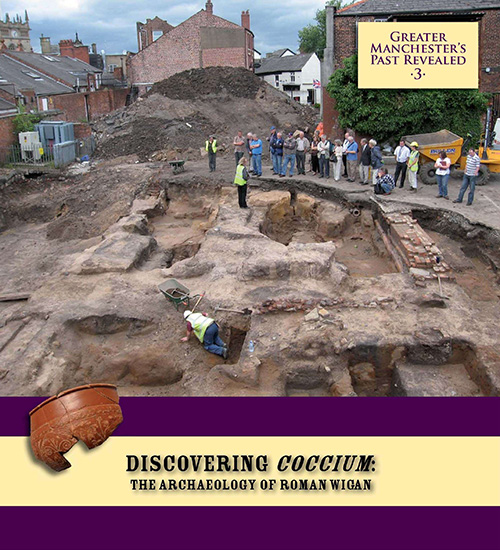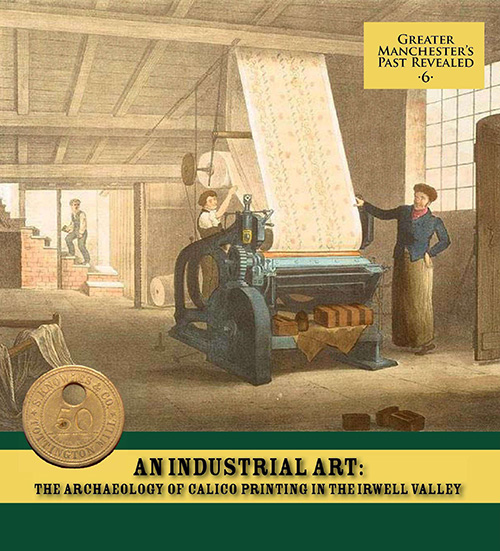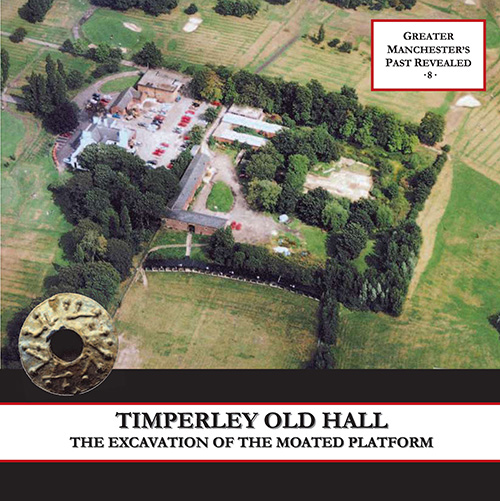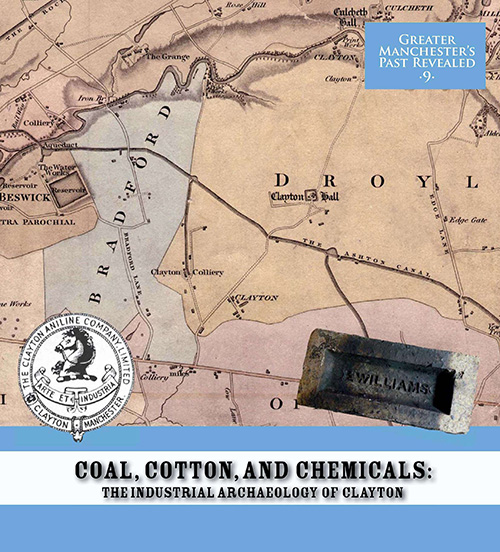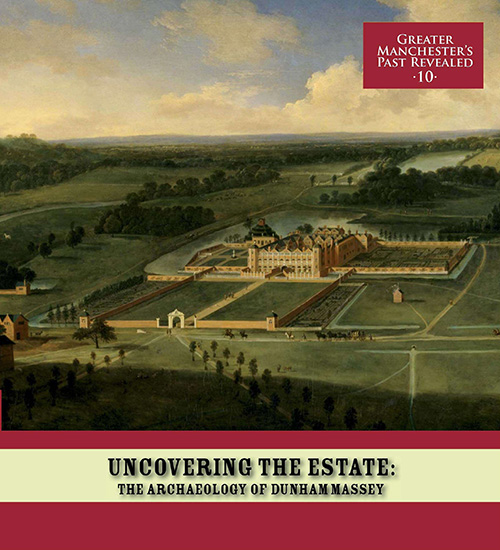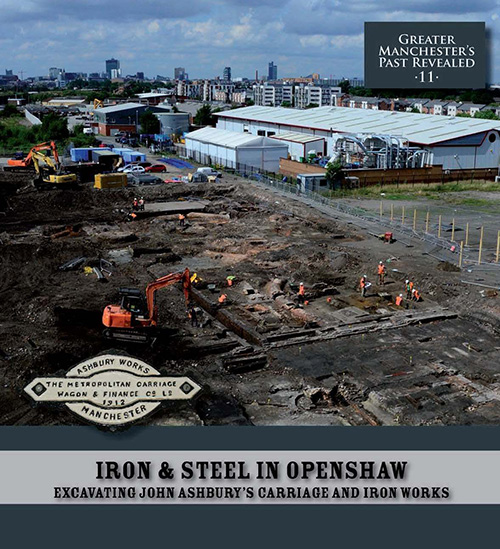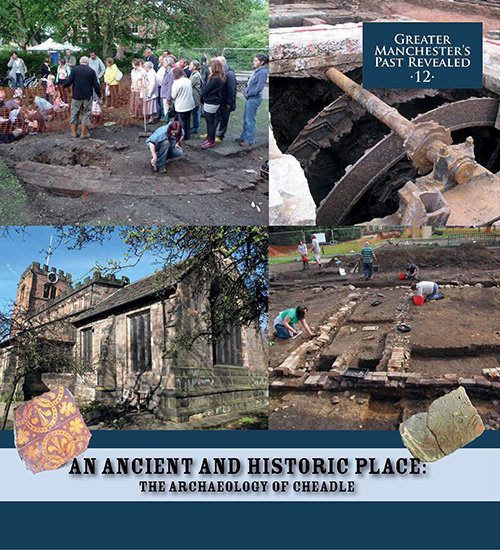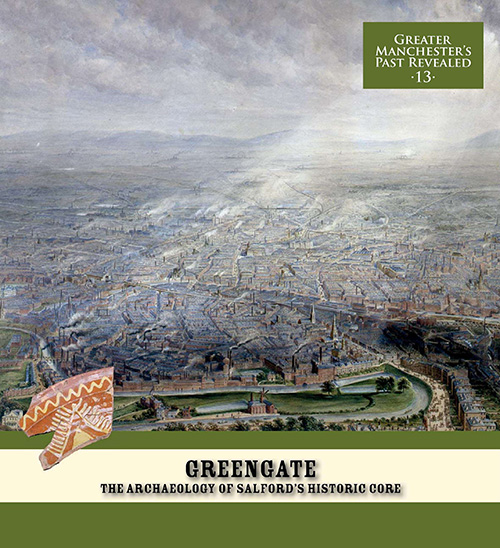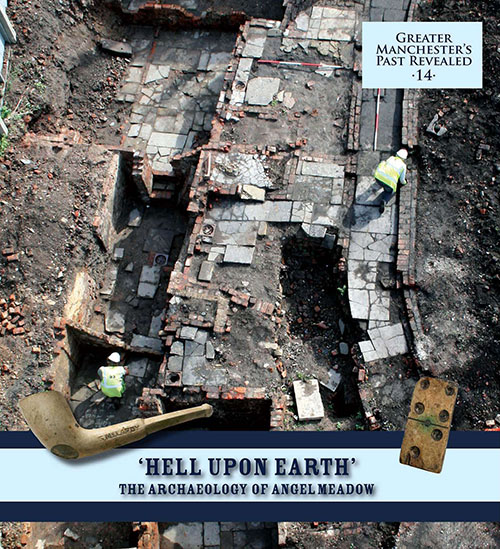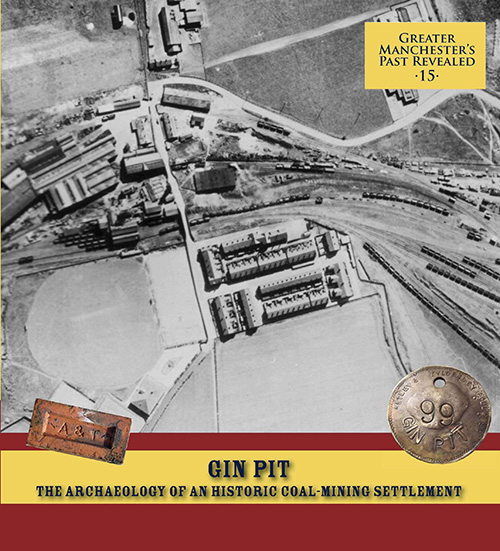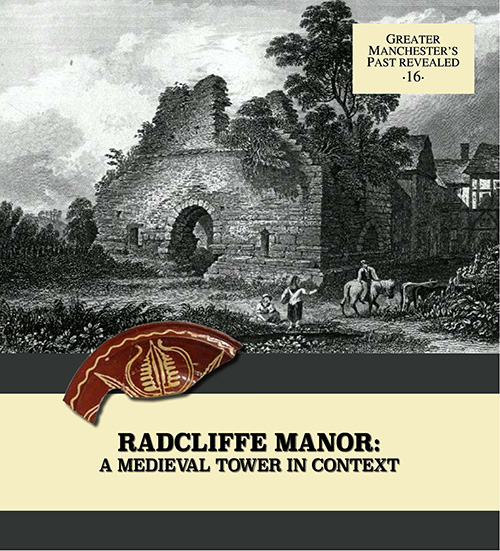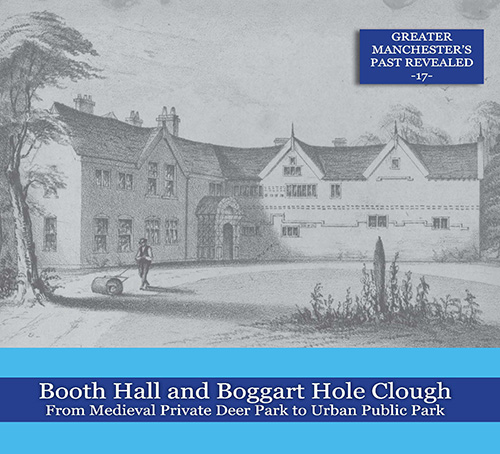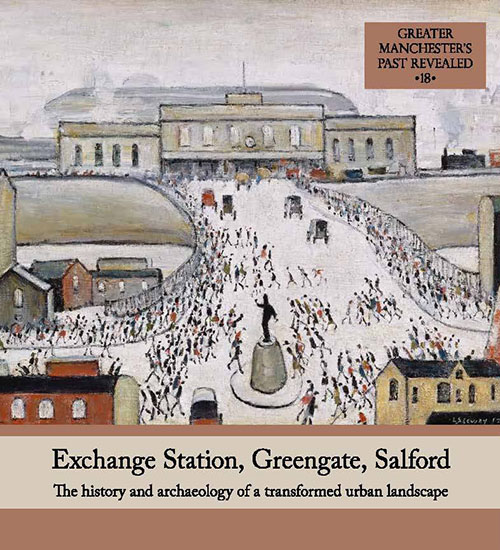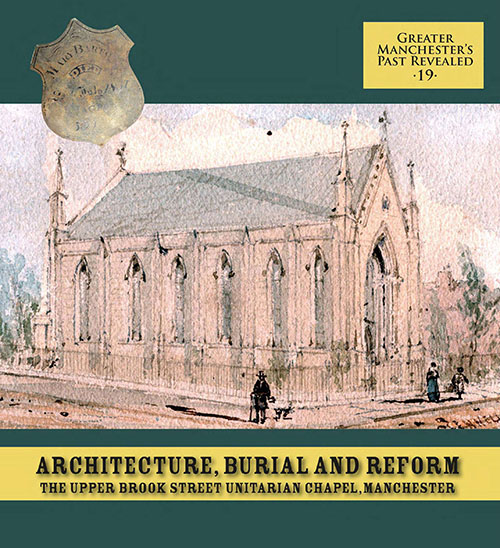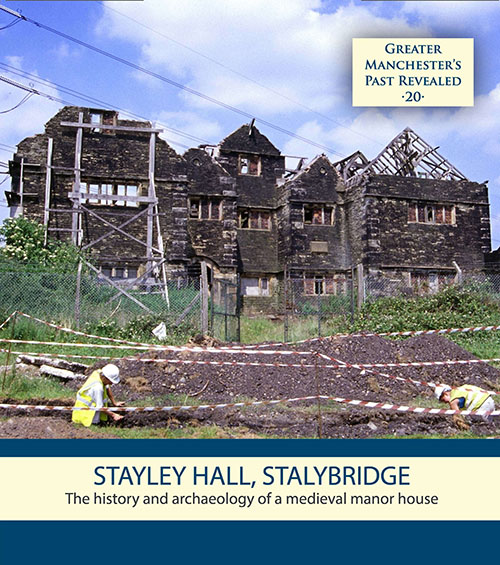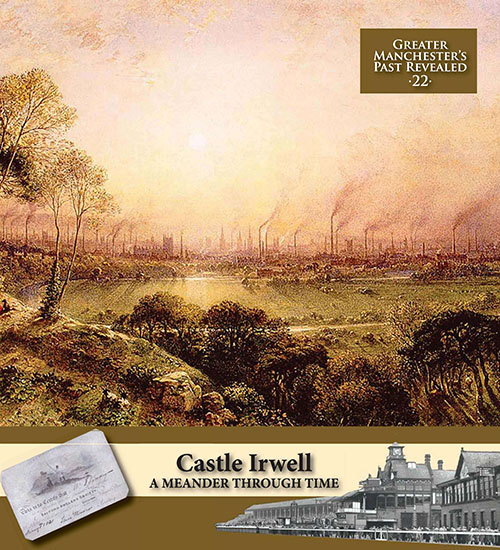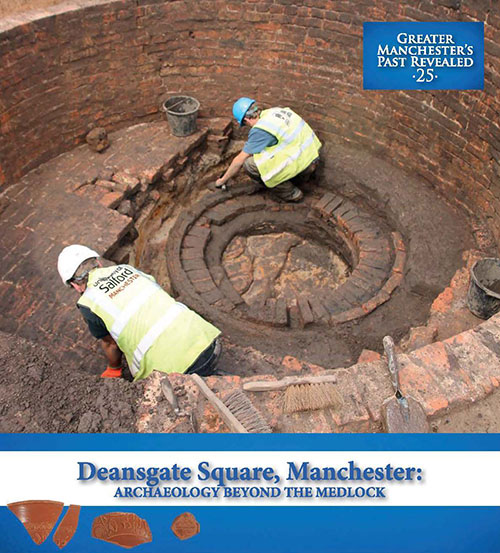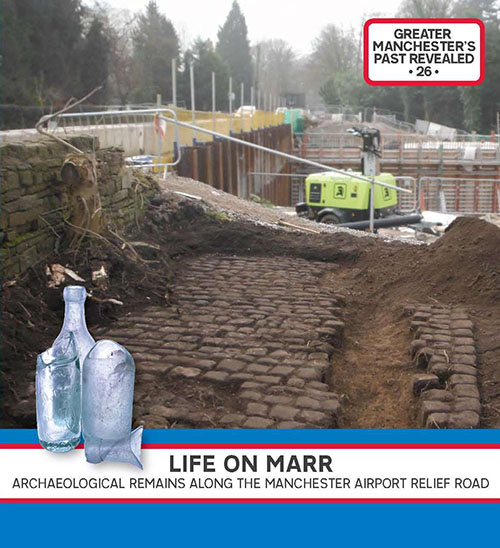Publications
Greater Manchester’s Past Revealed
One of the challenges facing modern archaeologists working in a commercial environment is sharing the findings from fieldwork projects in a format that is easily accessible. In 2010, the Greater Manchester Archaeology Unit (now the Greater Manchester Archaeological Advisory Service) addressed this issue by inaugurating a series of short booklets about the archaeology of the Manchester region. Rapidly gaining acclaim as a model of how the results of developer-funded archaeology can be made available to the general public, the volumes produced in the Greater Manchester’s Past Revealed series adhere to a uniform template that varies between 34 and 64 pages in length, heavily illustrated with historical maps, archive images and photographs of the work undertaken.
A total of 28 volumes had been produced by the end of 2020, covering a range of different sites across Greater Manchester that have been subject to research in advance of redevelopment. These include excavations of Manchester’s first purpose-built steam-powered textile mill and associated workers’ housing (Volume 1), a thriving 19th-century industrial suburb of Bury (Volume 2), collieries, iron foundries, chemical works, and railway engineering works in East Manchester (Volumes 4, 9 and 11). One booklet is dedicated to the region’s textile-finishing industries, and synthesises the research, survey and excavation of several calico printing works, bleach works and dye works along the Irwell Valley (Volume 6). All of these booklets provide the historical context for the archaeological work undertaken, an explanation of the industrial processes involved, and the planning context to each project.
Not all of the volumes have resulted from developer-funded work, however, and several describe community-led archaeology projects undertaken by local societies, including excavations at Newton Hall and Timperley Old Hall (Volumes 7 and 8), whilst Volume 10 summarises numerous excavations and surveys carried out on behalf of the National Trust on the Dunham Massey Estate. Volume 12 was produced as part of the 50th anniversary celebrations of the Cheadle Civic Society, and sets out the early history of the village and archaeological work carried out by local groups and as commercial excavations since 2005.
Since the inception of the series in 2010, there has been an intention to make the booklets freely available in a downloadable PDF format once the supply of hard copies becomes exhausted. This aspiration has now been achieved, and digital copies of this commended series are currently becoming available.
The Greater Manchester’s Past Revealed series currently includes the following titles:
Volume 1 arose from the remarkable remains uncovered during an excavation that was carried out in 2004-05 in advance of a major new development in the Piccadilly area of Manchester city centre. It was focused on the site of Manchester’s first purpose-built steam-powered cotton mill, and an adjacent block of late 18th- and early 19th-century cellar dwellings. It was one of the first large-scale excavations in the city to examine the buried remains of Manchester late 18th-century industrial townscape – Piccadilly Place: Uncovering Manchester’s Industrial Origins, Ian Miller, Chris Wild and Richard Gregory (Oxford Archaeology Ltd, 2010).
Volume 2 – The Rock Triangle, Bury: The Archaeology of an Industrial Suburb, Ian Miller and Richard Gregory (Oxford Archaeology Ltd, 2010)
Volume 2 examines the development and progress of the Rock Triangle in Bury, which emerged in the 19th century as a thriving industrial district of the town centre, characterised by numerous textile mills, engineering works and iron foundries, small workshops and rows of workers’ houses. These buildings had all been cleared by the end of the 20th century, but their foundations and the historic industrial townscape were uncovered during a series of excavations in 2006-07 as part of the Rock Retail and Leisure development – The Rock Triangle, Bury: The Archaeology of an Industrial Suburb, Ian Miller and Richard Gregory (Oxford Archaeology Ltd, 2010).
Volume 3 presents the exciting new evidence for Wigan’s early origins based on the truly remarkable discovery of a Roman bath house and part of the Roman fort during archaeological excavations on Millgate in the town centre. This is coupled with a summary of the numerous investigations carried out by the Wigan Archaeological Society that have attempted to identify the precise line of several Roman roads on their approach to Wigan – Discovering Coccium: The Archaeology of Roman Wigan, Ian Miller and Bill Aldridge (Oxford Archaeology Ltd, 2011).
Volume 4 traces the development of Bradford from a rural township on the eastern fringe of Manchester to the ‘engine room’ of the 19th-century industrial city, drawing on the evidence gained from archaeological excavations of Braford Colliery and the famous ironworks of Johnson & Nephew – Rediscovering Bradford: Archaeology in the Engine House of Manchester, Ian Miller (Oxford Archaeology Ltd, 2011).
Volume 5 summarises the Historic Landscape Characterisation Project, a major study that mapped the historic character and origins of Greater Manchester’s landscape, and presents some of the key themes that emerged from the data – Slices Through Time: Greater Manchester’s Historic Character Revealed, Norman Redhead and Lesley Mitchell (Greater Manchester Archaeological Unit, 2012).
Volume 6 presents an overview of the textile-printing industry, with particular reference to those works that were established in the Irwell Valley around Bury, utilising evidence from archaeological work carried out during the construction of the West East Link Main pipeline in Springwater Park, and a community excavation alongside the Kirklees Brook near Tottington – An Industrial Art: The Archaeology of Calico Printing in the Irwell Valley, Ian Miller (Oxford Archaeology Ltd, 2012).
Volume 7 examines Newton Hall in Tameside, one of the oldest buildings in north-west England, and presents the results of a community excavation that sought to investigate elements of the building that were lost when the estate was split up and sold – Newton Hall: Rediscovering a Manorial Complex, Michael Nevell (University of Salford, 2013).
Volume 8 presents the fascinating results from the South Trafford Archaeology Group’s excavations of Timperley Old Hall, the manorial home of the de Timperleigh family from the 13th century – Timperley Old Hall: The Excavation of the Moated Platform, Derek Pierce, Peter North and Michael Nevell (University of Salford, 2013).
Volume 9 derived from large-scale excavations in Clayton on the eastern fringe of Manchester, which developed in the 19th century as a key area for the production of chemicals. The excavations were focused on the site of the huge Clayton Aniline Works, which became a leading centre for the manufacture of synthetic dyes in the late 19th century, but also investigated a late 18th-century colliery, a textile mill and associated workers’ houses – Cotton, Coal and Chemicals: The Industrial Archaeology of Clayton, Ian Miller (Oxford Archaeology Ltd, 2013).
Volume 10 presents the findings of several archaeological excavations and surveys carried out across the Dunham Massey Estate near Altrincham, providing an insight into its rich and complex history – Uncovering the Estate: The Archaeology of Dunham Massey, Richard Gregory and Ian Miller (Oxford Archaeology Ltd, 2013).
Volume 11 provides an account of John Ashbury’s railway carriage and iron works in east Manchester, a large part of which was uncovered during an archaeological excavation in 2012 – Iron & Steel in Openshaw: Excavating John Ashbury’s Carriage and Iron Works, Laurence Hayes (SLR Consulting Ltd, 2014).
Volume 12 was produced as part of the 50th anniversary celebrations of the Cheadle Civic Society, and sets out the early history and archaeology of this ancient village, describing some of its most important historic buildings and significant archaeological discoveries – An Ancient and Historic Place: The Archaeology of Cheadle, Norman Redhead and Ian Miller (Cheadle Civic Society, 2014).
Volume 13 draws together the various archaeological excavations that have been carried out in the historic core of Salford since the late 1980s, providing an insight into the development of this important medieval, post-medieval and industrial-era town – Greengate: The Archaeology of Salford’s Historic Core, Richard Gregory and Ian Miller (Oxford Archaeology Ltd, 2015).
Volume 14 derives from the archaeological work carried out as part of the NOMA regeneration project in the Shudehill area of Manchester city centre, which provided a fascinating insight into the development of workers’ housing that once formed part of Angel Meadow, and also uncovered the remarkable remains of Manchester earliest steam-powered cotton mill – Hell Upon Earth: The Archaeology of Angel Meadow, Ian Miller and Chris Wild (Oxford Archaeology Ltd, 2015). This booklet was published in tandem with a detailed account of the excavation of Richard Arkwright’s cotton mill https://doi.org/10.1080/03090728.2016.1266214
Volume 15 is focused on the small industrial village of Gin Pit near Tyldesley, which developed from the mid-19th century to serve the area’s rapidly expanding coal trade. The booklet traces the origins and progress of the former colliery at the heart of the settlement that was subject to archaeological investigation in 2005-07 – Gin Pit: The Archaeology of an Historic Coal-Mining Settlement, Ian Miller and Alison Plummer (Oxford Archaeology Ltd, 2016).
Volume 16 presents the findings from a community excavation of Radcliffe Tower, which once formed part of a large manorial complex associated with one of Lancashire’s most important families during the medieval period. The booklet sets out the current understanding of the surviving building and the associated archaeological remains – Radcliffe Manor: A Medieval Tower in Context, Michael Nevell, Vicky Nash and Sarah Cattell (University of Salford, 2016).
Volume 17 summarises the history and archaeology of the former Booth Hall in Blackley, together with Boggart Hole Clough that once formed part of the associated estate – Booth Hall and Boggart Hole Clough: From Medieval Private Deer Park to Urban Public Park, Fiona Wooler and Richard Newman (Wardell Armstrong Archaeology, 2017).
Volume 18 complements the earlier volume dedicated to Salford’s historic core and explains the findings from an archaeological investigation of Greengate Exchange Station, which included a survey of the surviving structural elements of this once-important railway station and the medieval and post-medieval remains that were discovered beneath the building – Exchange Station, Greengate, Salford: The History and Archaeology of a Transformed Urban Landscape, Rebecca Haslam, Jennifer Proctor and Victoria Ridgeway (Pre-Construct Archaeology Ltd, 2017).
Volume 19 charts the growth and importance of Manchester’s 19th-century Unitarian congregation with reference to the results obtained from an excavation of the Upper Brook Street Unitarian Chapel and its associated graveyard – Architecture, Burial and Reform: The Upper Brook Street Unitarian Chapel, Manchester, Richard Gregory and Dawn Keen (Oxford Archaeology Ltd, 2018).
Volume 20 provides an in-depth account of Stayley Hall, an iconic building in the Tameside landscape that has been subject to a series of archaeological investigations – Stayley Hall, Stalybridge: The History and Archaeology of a Medieval Manor House, Jayne Rimmer (York Archaeological Trust, 2018).
Volume 21 considers Woodford Aerodrome, which was famously associated with the aircraft manufacturer Avro. Archaeological excavations within and around the former aerodrome have allowed the history of the site to be elucidated both before and following the arrival of Avro – Woodford: The Archaeology of a Landscape and Aerodrome, Richard Gregory (Oxford Archaeology Ltd, 2018).
Volume 22 – Castle Irwell: A Meander Through Time, Rachael Reader (Salford Archaeology, 2018)
Volume 22 sets out the key results gained from an archaeological investigation that was carried out as part of the Castle Irwell Flood Defence scheme, which has transformed a former meander of the river on the fringe of Salford – Castle Irwell: A Meander Through Time, Rachael Reader (Salford Archaeology, 2018).
Volume 23 draws together the data from a series of historic building surveys and archaeological excavations that were carried out across the Kingsway Business Park near Rochdale, providing a new appreciation of the local historic landscape – Yeoman Farmers and Handloom Weavers: The Archaeology of the Kingsway Business Park, Richard Gregory (Oxford Archaeology Ltd, 2019).
Volume 24 looks at Cutacre near Bolton, and explains the evolution of the landscape that was settled and developed during the prehistoric and historic periods, with large-scale coal mining becoming a notable feature of the 19th-century landscape. Amongst the remarkable findings from the excavation of the site were the remains of a Bronze Age settlement, evidence for medieval iron working, and several different types of post-medieval rural houses – Cutacre: Excavating a Prehistoric, Medieval and Post-Medieval Landscape, Richard Gregory (Oxford Archaeology Ltd, 2019).
Volume 25 presents the findings from a series of excavations carried out between 2015-19 as part of the Great Jackson Street Development, which provided important new evidence for Manchester’s Roman settlement on the south side of the River Medlock, and a fascinating insight into the industrial development of the area from the late 18th century – Deansgate Square, Manchester: Archaeology Beyond the Medlock, Ian Miller and Oliver Cook (Salford Archaeology, 2019).
Volume 26 summarises the archaeological work carried out during the construction of the Manchester Airport relief road, which uncovered remains dating from the Middle Bronze Age, together with a possible medieval moated manor, the foundations of a post-medieval corn mill at Norbury and a former toll house on the turnpike road between Macclesfield and Stockport – Life on Marr: Archaeological Remains along the Manchester Airport Relief Road, Patrick Daniel (Wessex Archaeology Ltd, 2020).
Volume 27 presents a series of excavations carried out along Chapel Street in Salford, which uncovered the foundations of workers’ housing with a date range spanning the early 18th to late 19th centuries, throwing new light onto an understanding of living conditions in the industrial city – Salford Regeneration: The Archaeology of Living in the City, Katie Fletcher (Salford Archaeology, 2020).
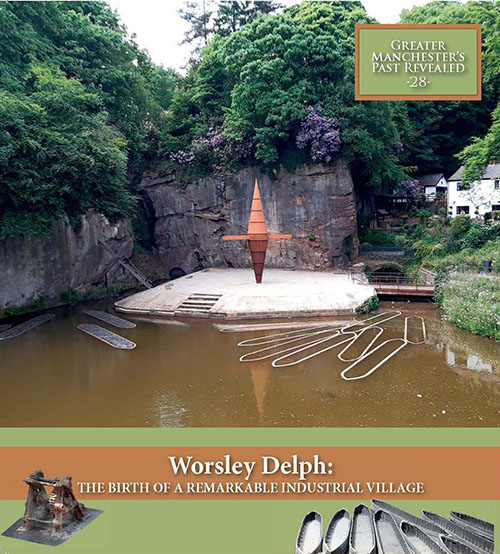
Volume 28 – Worsley Delph: The Birth of a Remarkable Industrial Village, Katie Fletcher and Ian Miller (Salford Archaeology, 2020)
Volume 28 describes the 18th-century transformation of Worsley from a quiet hamlet to a thriving inland canal port and one of the most famous centres of the Industrial Age. At the epicentre of this transformation was Worsley Delph, a small stone quarry that was adapted for use as a canal basin that linked the Bridgewater Canal with an incredible network of underground canals that penetrated the coal mines owned by the 3rd Duke of Bridgewater – Worsley Delph: The Birth of a Remarkable Industrial Village, Katie Fletcher and Ian Miller (Salford Archaeology, 2020).

Volume 29 presents the archaeological work undertaken during the construction of the Second City Crossing, a new line of the Metrolink, which uncovered the burial vaults and foundations of St Peter’s Church, and the exhumation of more than 250 burials from the graveyard associated with the Unitarian Chapel on Cross Street in Manchester city centre – Life and Death in Manchester: Excavations Along the Second City Crossing, Mark Bell, Melanie Johnson, Malin Holst and Martin Lightfoot (CFA Archaeology Ltd, 2021).

Volume 30 narrates the development of Douglas Green in the Pendleton area of Salford, which originated in the late 18th century as an ‘industrial colony’ that served one of the earliest cotton mills in Greater Manchester, established by the infamous factory master William Douglas. The hamlet lay in the shadow of the 16th-century Pendleton Hall, which was rebuilt by William Douglas in around 1777. The area developed subsequently as a key industrial and residential district that experienced decline and dereliction in the later 20th century as industry moved away – Douglas Green, Pendleton: The Archaeology of an Industrial Colony, Katie Fletcher and Ian Miller (Salford Archaeology, 2022).
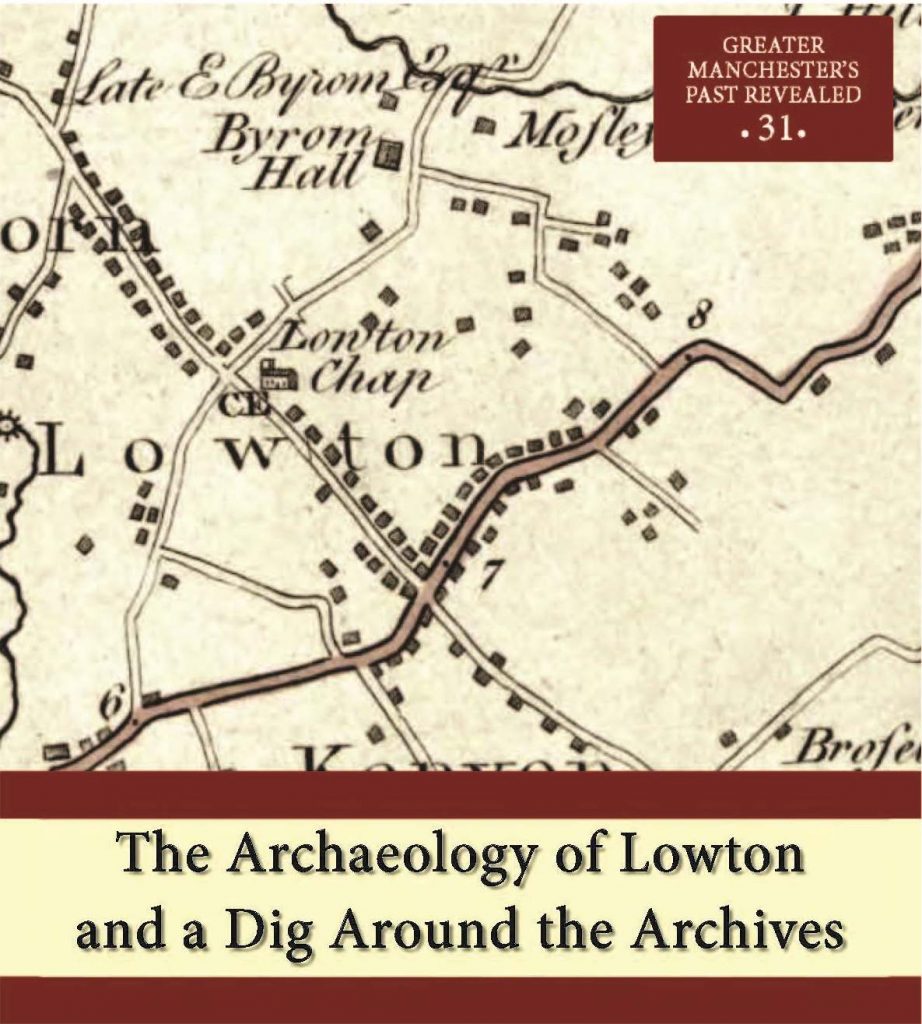
Volume 31 – The Archaeology of Lowton and a Dig Around the Archives, Kate Higgs (Wardell Armstrong LLP, 2022)
Volume 31 looks at the historic settlement of Lowton and its rural landscape and draws together a number of previously unpublished archaeological surveys and excavations that cumulatively tell the story of the village from the prehistoric period to the 21st century – The Archaeology of Lowton and a Dig Around the Archives, Kate Higgs (Wardell Armstrong LLP, 2022).
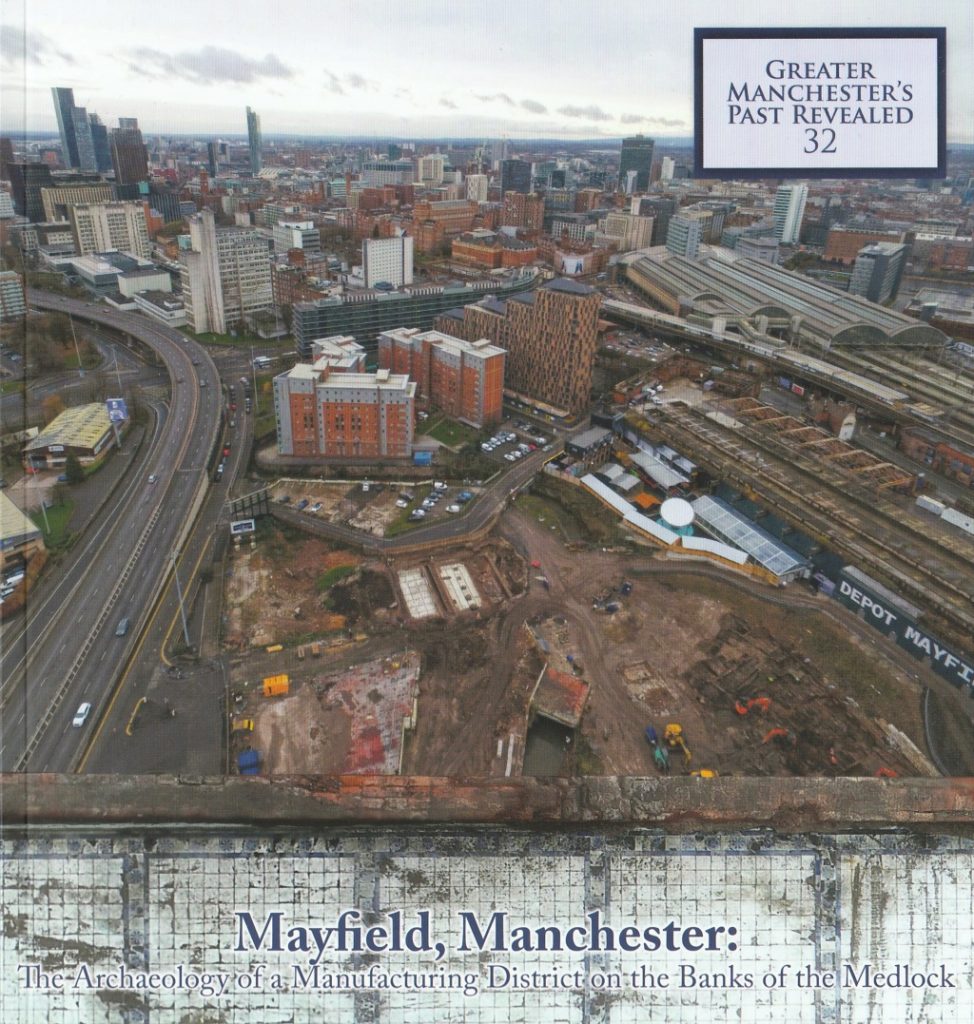
Volume 32 – Mayfield, Manchester: The Archaeology of a Manufacturing District on the Banks of the Medlock, Oliver Cook (Salford Archaeology, 2022)
Volume 32 summarises a major programme of archaeological excavations undertaken at Mayfield in Manchester city centre, focused on the site of Hoyle’s late 18th-century textile-printing works and one of the first public baths to be opened in the city – Mayfield, Manchester: The Archaeology of a Manufacturing District on the Banks of the Medlock, Oliver Cook (Salford Archaeology, 2022).
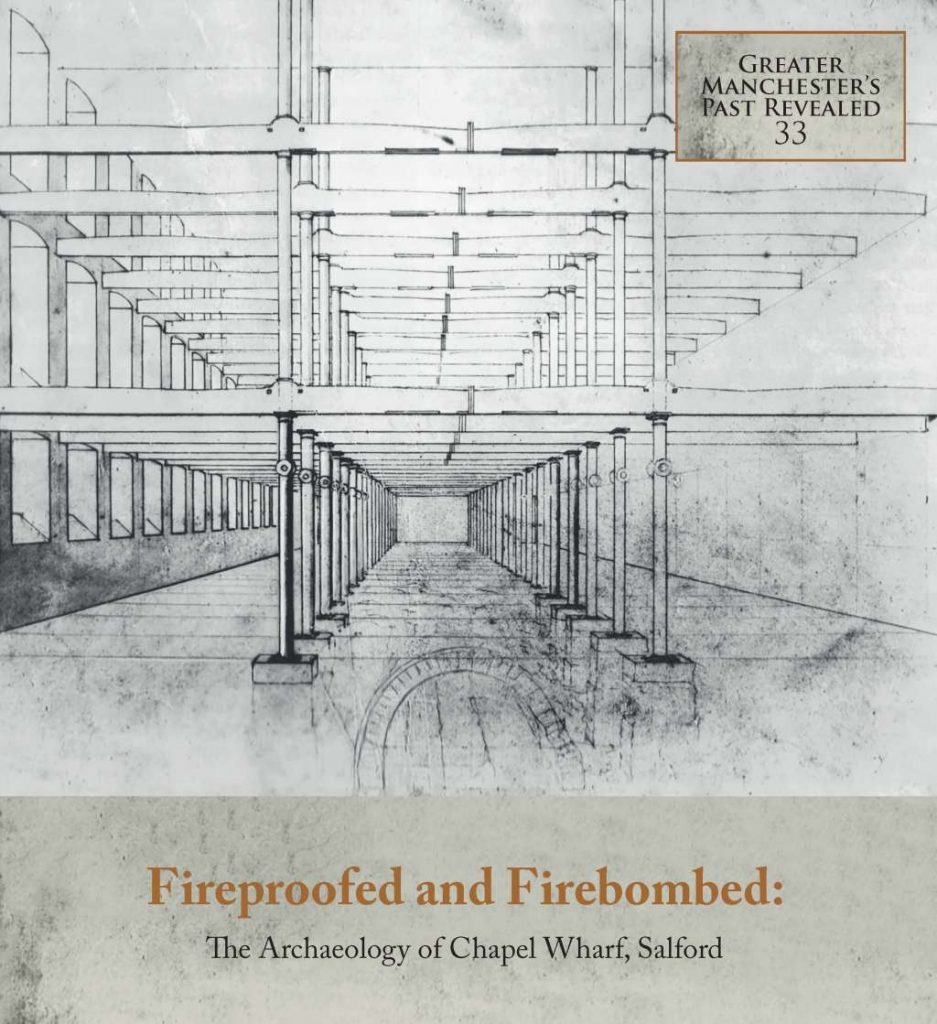
Volume 33 – Fireproofed and Firebombed: The Archaeology of Chapel Wharf, Salford, Katie Fletcher (Salford Archaeology Ltd, 2023)
Volume 33 presents and interprets the results obtained from a series of archaeological excavations that were carried out at Chapel Wharf between 2005-16, providing an insight into Salford’s historic townscape. In particular, the excavation uncovered the remains of the Salford Twist Mill, one of the world’s first iron-framed and gas-lit buildings – Fireproofed and Firebombed: The Archaeology of Chapel Wharf, Salford, Katie Fletcher (Salford Archaeology Ltd, 2023).


